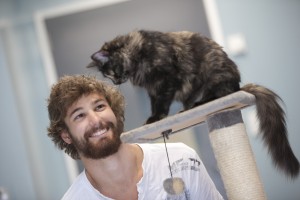 Hiding may play an important role in relaxing cats according to University of Queensland honours student Mark Owens.
Hiding may play an important role in relaxing cats according to University of Queensland honours student Mark Owens.
Working in the Centre of Animal Welfare and Ethics , Owens’ project focuses on the behaviour and welfare of domestic cats in shelters.
“Welfare is a major issue in many countries for animals that are kept in cages, shelters and captive environments like zoos,” he said.
The study looks at cats’ behaviours and emotions, which indicate if they are feeling stressed, anxious, frustrated or content and examines 37 cats over seven days.
Half the cats Owens is observing are provided with a hiding box, and the remaining cats are in open view.
“A big part of my research is whether hiding provides a certain type of enrichment for cats in stressful situations,” Owens said.
“Unfortunately I am not sitting in a room playing and watching cats, I have pre-recorded the cats for 24 hours over seven days, and have just finished coding their behaviours on the videos,” he said.
A cat’s position in the cage, its posture and certain escape behaviours are all observations that contribute to identifying their emotions, stress levels and ability to adapt to their environment. “I chose to do this project because I am very interested in the behaviour of domestic animals,” Owens said.
“I hope my research will benefit animal shelters, and will allow them to recognise stressful behaviours in cats and ways to decrease these kinds of behaviours,” he said.
The study continues on from preliminary research in Canada where over three days, 39 cats, which were housed in a shelter, showed significant behavioural and emotional changes.
Owens completed a Bachelor of Wildlife Science last year and will finish his Honours project at the end of the year.

